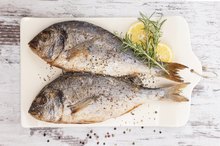What Are Benefits of Cutting Meat Out of Diet?
A diet without meat might fit with your ethical or religious beliefs, and it might have the reputation of being healthier than a diet with meat, with more beneficial nutrients and fewer harmful components. However, cutting meat out of your diet is only healthy if you are eating a balanced diet with plenty of other nutrient-dense foods.
Lower Cholesterol Levels
Your saturated fat and cholesterol consumption might decrease when you cut meat out of your diet, and this could result in lower cholesterol levels in your blood. Meat, such as fatty steaks or chicken with the skin, can be high in saturated fat and cholesterol, according to the Harvard School of Public Health. Not all meatless fats are healthy, so when you cut out meat from your diet, do not replace it with saturated fats such as those in full-fat cheese, butter, palm oil or coconut oil.
Lower Blood Pressure
Nutritional Value of Bluegills
Learn More
Cutting meat out of your diet might help you reduce your sodium intake, leading to a healthier blood pressure and lower risk for stroke or heart disease. Processed meats and meat dishes, such as sausages, bacon, cold cuts, burgers, burritos and tacos, are main contributors of sodium in the average U.S. diet, according to the 2010 Dietary Guidelines from the U.S. Department of Health and Human Services. Replace these foods with low-sodium, high-potassium choices, such as beans.
- A diet without meat might fit with your ethical or religious beliefs, and it might have the reputation of being healthier than a diet with meat, with more beneficial nutrients and fewer harmful components.
- Not all meatless fats are healthy, so when you cut out meat from your diet, do not replace it with saturated fats such as those in full-fat cheese, butter, palm oil or coconut oil.
Better Nutrition
When you cut meat out of your diet and replace it with alternative sources of protein, you increase your intake of some essential nutrients, such as dietary fiber or healthy unsaturated fats from beans and lentils or soy-based meat substitutes. Getting protein from dairy products means increasing your calcium intake, too. Be cautious about cutting meat out of your diet if you are a woman of child-bearing age and at risk for iron deficiency because many kinds of meat are rich in iron, an essential mineral for healthy red blood cells.
Weight Control
Low-Cholesterol Meat & Fish
Learn More
Cutting meat out of your diet might help you cut calories and lose weight. Beef and chicken dishes; fatty, processed meats, such as sausages, bacon and hot dogs; burgers; and cold cuts are among the top sources of calories in the average American diet, according to the 2010 Dietary Guidelines from U.S. Department of Health and Human Services. Weight loss means eating fewer calories than you expend, and you will only lose weight by cutting meat out of your diet if you do not replace all of the calories from meat with calories from other foods.
Related Articles
References
- U.S. Department of Health and Human Services: Dietary Guidelines for Americans, 2010
- Cleveland Clinic. Cholesterol & nutrition: TLC.
- Health.gov. Dietary guidelines 2015-2020.
- American Heart Association. Fish and omega-3 fatty acids. Reviewed March 23, 2017
- American Heart Association. Meat, poultry, and fish: picking healthy proteins. Reviewed March 26, 2017
- American Heart Association. Top ten tips for healthy grilling and barbecuing. Reviewed February 9, 2017
- National Cholesterol Education Program. Third Report of the Expert Panel on Detection, Evaluation, and Treatment of High Blood Cholesterol in Adults. 2002.
- Rolfes SR, Whitney E. Understanding Nutrition. 14th ed. Independence, KY: Wadsworth Publishing; 2015.
- The American Heart Association. Meat, Poultry, and Fish: Picking Healthy Proteins. 2016.
- U.S. Food and Drug Administration. Guidance for Industry: A Food Labeling Guide. 2013.
Writer Bio
Natalie Stein specializes in weight loss and sports nutrition. She is based in Los Angeles and is an assistant professor with the Program for Public Health at Michigan State University. Stein holds a master of science degree in nutrition and a master of public health degree from Michigan State University.









